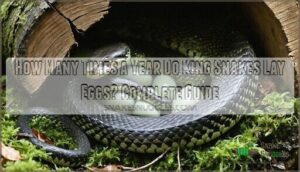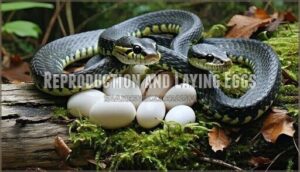This site is supported by our readers. We may earn a commission, at no cost to you, if you purchase through links.
 If you’re wondering how many times a year do king snakes lay eggs, the answer is straightforward: just once annually.
If you’re wondering how many times a year do king snakes lay eggs, the answer is straightforward: just once annually.
King snakes follow nature’s schedule like clockwork, laying their single clutch between April and July when conditions are perfect. Unlike chickens that keep cranking out eggs, these serpents put all their reproductive effort into one well-timed batch of 3-24 leathery eggs.
Female king snakes choose cozy spots like rotting logs or compost heaps to deposit their precious cargo, ensuring ideal temperature and humidity.
This once-yearly pattern makes them predictable breeders, though several factors can influence their timing and success rates, and they lay eggs in a single clutch, which is a well-timed batch.
Table Of Contents
- Key Takeaways
- How Many Times a Year Do King Snakes Lay Eggs?
- Reproduction and Laying Eggs
- Breeding and Mating Habits
- Egg Incubation and Hatching
- Number of Eggs Laid Per Year
- Egg Laying Timeline and Frequency
- Influence of Climate on Egg Laying
- Factors Affecting Egg Laying in Captivity
- Conservation and Reproduction in The Wild
- Frequently Asked Questions (FAQs)
- How often do king snakes lay eggs?
- Is it good to have a king snake in your yard?
- How often do baby king snakes shed?
- What is the lifespan of a king snake?
- What do king snake eggs look like?
- How long do king snakes live?
- Do king snakes eat their own eggs?
- Can king snakes reproduce without mating?
- What predators threaten king snake eggs?
- Conclusion
Key Takeaways
- King snakes lay eggs only once a year, typically between late spring and early summer.
- They deposit a single clutch of 3-24 leathery eggs in warm, moist environments like rotting logs or compost heaps.
- Ensuring proper temperature and humidity is crucial for successful egg incubation, with hatchlings emerging after 55-75 days.
- Factors like climate, diet, and overall snake health influence the timing and success of their annual reproduction.
How Many Times a Year Do King Snakes Lay Eggs?
You’ll find that king snakes typically lay eggs just once annually, making their Annual Clutch Count relatively straightforward.
Their Laying Seasonality runs from March through August, with most females depositing their clutches during early summer.
Unlike some reptiles, Double Clutching rarely occurs in king snakes.
This consistent king snake egg laying frequency means you can expect one reproductive cycle per year throughout their Reproductive Lifespan.
Reproduction and Laying Eggs
Understanding how king snakes reproduce helps you appreciate these fascinating non-venomous colubrid snakes found throughout eastern North America.
King snakes turn reproduction into an annual masterpiece, laying eggs once yearly with remarkable consistency throughout their breeding lives.
Once your king snake reaches sexual maturity around 2-4 years old, she’ll typically lay king snake eggs once annually during snake reproduction season.
Snake egg laying follows a predictable pattern that makes king snake breeding manageable for enthusiasts:
- Mating occurs in spring after emerging from winter dormancy
- Females lay 3-24 eggs in early summer, usually 10-14 days after pre-laying shed
- Eggs incubate for 55-75 days in moist environments at 80°F
Unlike double clutching seen in some species, king snakes stick to their annual schedule.
Parthenogenesis rarely occurs, and while inbreeding risks exist in captivity, healthy adults consistently produce viable clutches when proper conditions are maintained.
Breeding and Mating Habits
King snakes turn courtship into a fascinating spectacle each breeding season. You’ll witness males engaging in intense mating competition, wrestling like serpentine gladiators for female attention.
These elaborate courtship rituals involve chemical tracking and territorial displays that’d make any nature documentary proud.
| Breeding Aspect | Details |
|---|---|
| Sexual Maturity | 2-4 years of age |
| Mating Season | March through August |
| Competition Style | Wrestling matches between males |
Sexual maturity determines breeding readiness, while reproductive health affects success rates.
Wild populations face inbreeding risks due to limited territory ranges, influencing king snake breeding patterns and overall king snake egg laying frequency.
Egg Incubation and Hatching
Once your king snake lays her eggs, you’ll need to master the art of incubation. The incubation period spans 50-75 days, depending on incubation temperature—warmer conditions around 80°F speed things up.
These leathery-shelled treasures absorb moisture during snake egg incubation, so maintain proper humidity levels. Candling eggs helps assess egg viability by revealing developing embryos inside.
For maximum control, consider using a specialized incubator. Keep eggs in vermiculite or perlite substrate, avoiding disturbance.
The soft shell texture distinguishes snake eggs from bird eggs. Proper king snake egg incubation guarantees hatchling success when babies emerge using their egg tooth.
Number of Eggs Laid Per Year
Calculating the clutch size for your kingsnake reveals fascinating patterns in their annual reproduction.
Most species produce 3-29 eggs per clutch, with king snake egg clutch size varying by the female’s size and health.
California kingsnakes typically lay 5-15 eggs, while eastern varieties produce 6-20.
Your snake’s laying capacity depends on her reproductive maturity, diet quality, and environmental conditions.
Larger females consistently outperform smaller ones in egg count, making size a reliable predictor of kingsnake reproduction success and overall egglaying frequency throughout their breeding years.
You can find kingsnake breeding supplies at various retailers.
Egg Laying Timeline and Frequency
Most king snakes follow predictable Annual Egg-Laying patterns that’ll help you understand their Reproductive Cycles. Laying Seasonality typically occurs once yearly during late spring through early summer, though Clutch Intervals can vary based on environmental conditions.
Proper egg incubation supplies are essential for successful hatching.
Here’s what affects snake egg frequency:
- Temperature fluctuations influence the king snake egg laying timeline
- Food availability determines reproductive readiness and energy reserves
- Geographic location shifts seasonal timing by several weeks
- Individual health impacts how often snakes lay eggs successfully
Double Clutching remains rare but possible under ideal conditions.
Influence of Climate on Egg Laying
Climate shapes your king snake’s reproductive calendar in fascinating ways.
Climate orchestrates your snake’s breeding dance with seasonal precision and environmental flair.
Temperature Impact triggers spring mating behaviors, while Seasonal Shifts determine whether eggs arrive in early summer or fall.
Rainfall Effects influence humidity levels essential for successful incubation, and Habitat Variation means desert kingsnakes face different challenges than forest dwellers.
Warmer regions see earlier kingsnake egg laying season cycles, while cooler areas delay reproduction.
Climate Change increasingly disrupts traditional egg laying timeline patterns, forcing these adaptable serpents to adjust their ancient rhythms to survive changing environmental conditions.
Successful incubation relies on stable temperature and humidity for viable eggs.
Factors Affecting Egg Laying in Captivity
When you’re breeding king snakes in captivity, you’ll need to control several key factors that directly influence their egg-laying success, including temperature regulation, proper nutrition, and stress reduction.
Your snake’s reproductive health depends on maintaining consistent environmental conditions, providing adequate food resources, and creating secure nesting sites that mimic their natural habitat preferences, which is crucial for their overall well-being and reproductive health.
Egg Laying Frequency
When you’re keeping kingsnakes in captivity, you’ll find their egg laying frequency follows predictable patterns.
Your female will typically produce one Annual Clutch Count per year, though Double Clutching rarely occurs in ideal conditions.
Frequency Factors like nutrition, temperature, and stress levels directly impact Laying Consistency throughout her Reproductive Lifespan, making proper husbandry essential for reliable kingsnake egg laying season success.
Egg Incubation
Mastering kingsnake egg incubation requires attention to detail, but it’s surprisingly straightforward once you understand the basics.
Your incubation environment directly impacts egg viability and the hatching process success.
Here are four critical factors for ideal kingsnake egg incubation:
- Temperature control: Maintain 80°F consistently throughout the incubation period for best results
- Humidity levels: Keep moisture near 100% to prevent eggs from drying out during development
- Incubation medium: Use vermiculite or perlite substrate to regulate moisture around eggs
- Ventilation: Provide adequate airflow to prevent harmful gas buildup as hatching approaches
Egg Binding
While proper incubation sets the stage for healthy hatching, sometimes things don’t go as planned.
Egg binding (dystocia) occurs when your kingsnake can’t pass her eggs naturally. Causes include poor nutrition, dehydration, stress, or inadequate nesting conditions.
Watch for symptoms like restless behavior, straining, or visible birthing efforts without producing eggs.
Prevention starts with proper husbandry—maintain correct temperatures, humidity levels, and provide suitable nesting boxes with appropriate substrate.
If egg binding occurs, don’t wait it out. Seek immediate veterinary care, as surgical removal may be necessary to prevent serious complications or death.
Conservation and Reproduction in The Wild
Wild populations of king snakes face mounting challenges that directly impact their reproduction in the wild.
Habitat loss from urban development and agriculture shrinks their breeding territories, forcing snakes into smaller areas where finding mates becomes difficult.
You’ll notice that Climate Impacts alter their natural snake reproduction cycle, shifting traditional egg laying habits as temperatures rise earlier each spring.
Conservation Efforts focus on protecting genetic diversity within kingsnake populations, as isolated groups risk inbreeding.
When habitats fragment, you’re basically creating snake islands where reproduction becomes limited.
Wild Populations depend on connected corridors that allow genetic mixing between groups.
Researchers track king snake egg laying frequency to understand how environmental pressures affect breeding success.
Unlike captive snakes with controlled conditions, wild females must balance survival with reproduction.
Poor weather, limited prey, or disturbed nesting sites can skip entire breeding seasons.
Conservation programs now monitor these patterns to identify at-risk populations before they decline too far.
King snakes, being carnivorous, require high calorie food to maintain their energy levels for successful reproduction.
Frequently Asked Questions (FAQs)
How often do king snakes lay eggs?
Like clockwork, you’ll find king snakes lay eggs just once per year.
They’re not marathon breeders – females typically deposit their clutch during late spring or early summer, then you’ll wait until fall for hatching.
Is it good to have a king snake in your yard?
Having a king snake in your yard is beneficial because they’re natural pest controllers, eating rodents and other snakes, including venomous species.
They’re non-venomous and generally avoid humans, making them excellent neighbors, and thus natural pest controllers.
How often do baby king snakes shed?
Baby king snakes molt like they’re outgrowing their favorite jeans—you’ll see them shed their skin multiple times during their first year as they rapidly grow.
Typically, this growth happens every 4-6 weeks until they reach maturity.
What is the lifespan of a king snake?
You can expect your king snake to live 15-20 years in captivity with proper care, while wild specimens typically survive 10-15 years due to predators, disease, and environmental challenges.
What do king snake eggs look like?
You’ll recognize king snake eggs by their soft, leathery texture and white to beige coloring.
They’re round or oval-shaped, clustering together in groups, unlike bird eggs which feel hard and sit separately.
How long do king snakes live?
In the wild, you’ll find king snakes typically live 10-15 years, though they can reach 20 years with proper care in captivity.
Their lifespan depends on factors like diet, habitat quality, and predator pressure.
Do king snakes eat their own eggs?
Don’t put all your eggs in one basket when assuming king snakes eat their own.
They’re actually excellent parents who don’t consume their eggs, instead abandoning them after laying to develop naturally without interference.
Can king snakes reproduce without mating?
King snakes can’t reproduce without mating through normal sexual reproduction.
However, some snake species exhibit parthenogenesis, where females produce unfertilized eggs that rarely develop into viable offspring, though this isn’t documented in kingsnakes.
What predators threaten king snake eggs?
You’ll find that various predators threaten king snake eggs, including raccoons, skunks, opossums, birds like crows and jays, ants, beetles, and other snakes.
These opportunistic hunters actively seek out buried clutches for easy meals.
Conclusion
Understanding how many times a year do king snakes lay eggs isn’t rocket science—these serpents stick to nature’s tried-and-true schedule of once annually.
You’ve learned that timing, environment, and health all play vital roles in their reproductive success.
Whether you’re caring for captive king snakes or simply fascinated by wild populations, this knowledge helps you appreciate their predictable breeding patterns.
Remember, patience is key when working with these remarkable reptiles and their single yearly clutch.
- https://animaldiversity.org/accounts/Lampropeltis_getula
- https://www.petplace.com/article/reptiles/general/snake-egg-incubation
- https://animal-pedia.org/snakes/king-snake
- https://pmc.ncbi.nlm.nih.gov/articles/PMC8820112
- https://bioone.org/journals/the-american-midland-naturalist/volume-148/issue-1/0003-0031_2002_148_0102_SAOTFK_2.0.CO_2/Seasonal-Activity-of-the-Florida-Kingsnake-Lampropeltis-getula-floridana-Serpentes/10.1674/0003-0031(2002












